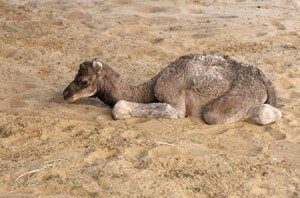Dolly was so 90’s. Most of us are waiting for scientists to clone something awesome, like velociraptors or wholly mammoths… hell, even a giant sloth would be cool. But, to quote Dr. Leo Marvin, it’s all about baby steps. We started with a tadpole, moved on to sheep and cows, and soon… we’ll have Jurassic Park in no time.
So how many critters have we actually cloned so far? Well, short of an exhaustive list, we’ve copied cats, dogs, horses, pigs, mules, ferrets, buffalo, fruit flies, fish and even a rheses monkey. This research is taking place all over the world, from the US and France to Argentina and Iran. The People’s Republic, whose biotech is booming, is of course also on the front lines of cloning technology. And this month, the United Arab Emerites, home of The World, just gave the actual world its first cloned camel.

Her name is Injaz (Arabic: “achievement”), and she was born on April 8 in Dubai after an “uncomplicated” gestation of 378 days. Just like her genetically identical mother (twin sister?), she has one hump, and as you can see from the picture she looks… well, just like a camel. She joins a long list of cloned mammals that have popped up in Dolly’s wake, an amazing amount of progress considering it’s only been twelve years.
The cloning procedure called somatic cell nuclear transfer (SCNT) removes the DNA from an unfertilized egg and replaces it with DNA from a cell of an adult organism. In the case of Injaz, scientists used DNA from an ovarian cell of an adult female camel and fused it with an egg cell, using chemicals to induce cell division. The embryo was grown in culture for a week, after which it was implanted into a surrogate camel’s uterus. Bake for a year or so, and POOF! The desert has another camel!
This genetic swap doesn’t usually work, as the egg rarely divides normally to bring an embryo to term. Despite the inefficiencies, this process occasionally produces a viable, living clone. As such, Injaz was the first success after many failed attempts on the part of UAE’s appropriately-named Camel Reproduction Centre. They hope to use this technique to preserve and revive the DNA of strong racing camels. Seriously.
The SCNT technique has been caught in the crossfire of ethical debates surrounding stem cell therapy. Human stem cells created through SCNT could be used in organ transplants and repair, to study disease, and for other medical therapies. But while the technique doesn’t use human embryos (calming some), it could potentially create a human clone (alarming others). And since the procedure of induced pluripotentcy hit the market with impressive results, the demand for SCNT-derived stem cells has waned.
So what’s next? A major focus is always cloning extinct species, but finding high quality DNA can be a hassle. Still, progress is being made. Usually, frozen cells are no good because ice crystals damage the genetic material. But last year, mice that had been frozen for 16 years were cloned successfully. That could open the door to cloning a number of extinct species that we have on ice. Cloning could also be used to boost population levels in endangered species, helping to preserve the balance of ecosystems in our rapidly changing world.
And what about us? Most folks agree that cloning humans raises some legitimate ethical queries regarding the humanity of a clone, the legal status of a cloned embryo, and the sci-fi creepiness of having another you walking around. But I have to admit, the UAE’s idea to clone racing camels makes me think we should get Lance Armstrong’s cells on ice, pronto. Hear that, France? Seven more years.



